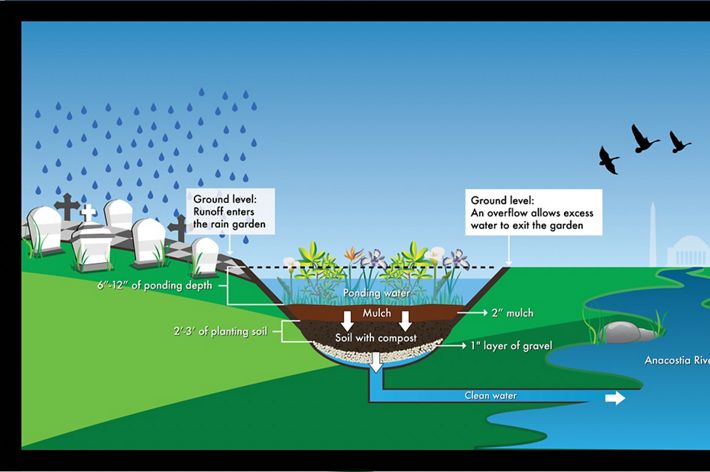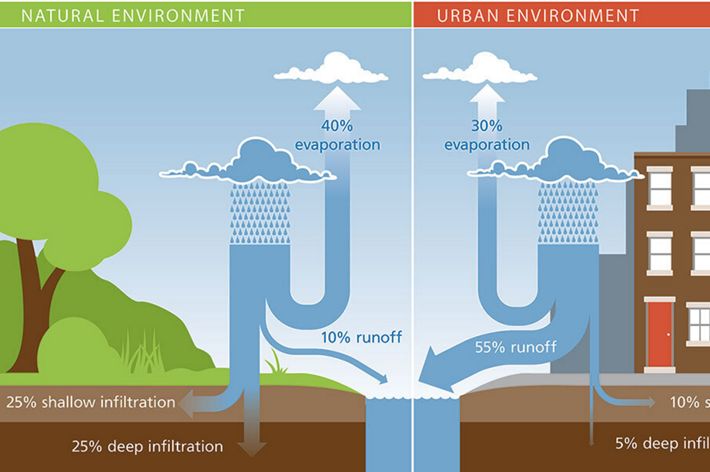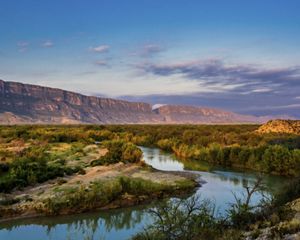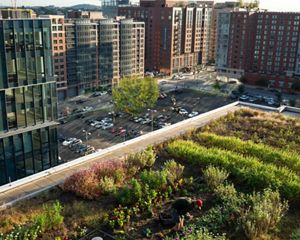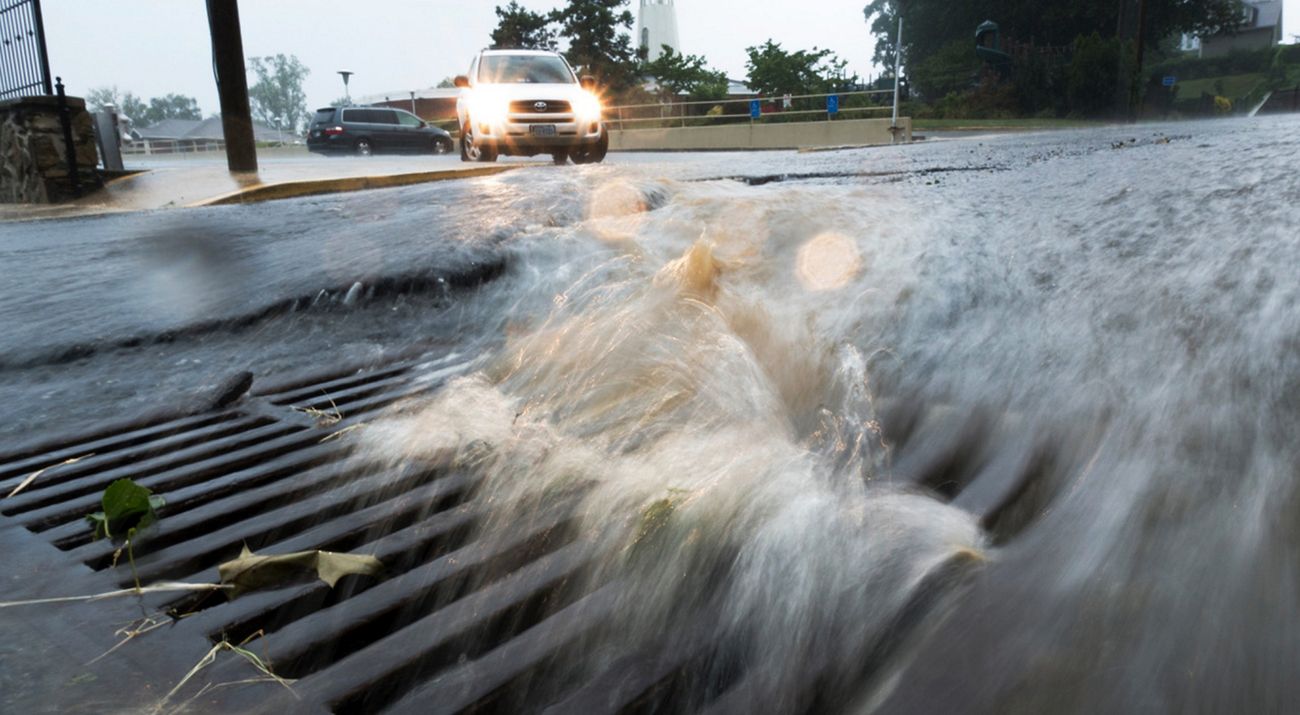
Satellite Imagery Highlights Ties Between Green Streets and Healthy Streams
Stormwater is a leading source of water pollution globally, and it’s on the rise in the United States.
Nature has a plan for rain. Rainwater soaks into the earth or is absorbed by plants—which filter out pollutants—rather than all running into waterways. But it’s a different story in cities. Rooftops, pavement, parking lots and other ‘impervious surfaces’ severely hinder rain from soaking into the ground or flowing across natural, pollution-filtering landscapes.
Most stormwater systems in our cities treat rainfall as a nuisance that’s quickly moved away from people and property. This approach produces large amounts of polluted runoff that eventually makes its way into rivers, lakes, reservoirs, wetlands and estuaries, where it impacts both people and nature. And stormwater runoff often flows into combined wastewater treatment plants that can send raw sewage into our water resources during heavy rains.
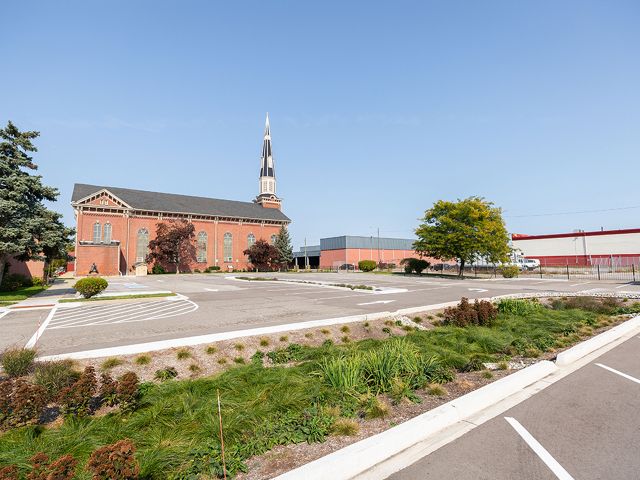
A green stormwater infrastructure project at the Sacred Heart Church in Detroit shows how such projects can protect water quality, reduce flooding and provide social and economic benefits.
Making the case for nature in cities
Researchers from The Nature Conservancy (TNC) and 2NDNATURE are now studying this problem from a bigger perspective—a much bigger perspective. A new peer reviewed study published in the journal Science of the Total Environment uses satellite imagery to help fill critical gaps in understanding how green stormwater infrastructure (GSI) and urban greenness or “nature-based solutions” influence hydrology.
GSI, which includes features like rain gardens, "smart” stormwater retention ponds, constructed wetlands or urban tree canopy, is now widely recognized as a means to reduce the impacts of urban runoff and meet municipal water quality permit requirements.
“A decade ago, we didn’t have the data nor the technology to efficiently conduct these types of studies at scale,” said Gary Conley, Chief Scientist at 2NDNATURE. “Today, we can use readily available satellite data of the entire planet and draw interesting conclusions about how the greening of urban areas impacts the health of urban streams.”
Quote: Gary Conley
Today, we can use readily available satellite data of the entire planet and draw interesting conclusions about how the greening of urban areas impacts the health of urban streams.
Designing the study with data and images
For nearly 400 urban watersheds around the U.S., the researchers combined hydrologic data from United States Geological Survey (USGS) gauges with images taken from Landsat satellites that show how much urban vegetative cover was lost or gained from 1985 to 2019. The study also synthesized available data from 44 of these urban watersheds where green stormwater infrastructure projects had been implemented.
This approach helped quantify the many co-benefits of increased vegetative cover and GSI implementation. Unfortunately, the study found that only 9 percent of the watersheds analyzed showed significant greenness trends—and a majority showed reductions. But in the watersheds with increased greenness, there were significant benefits to stormwater management, resulting in healthier urban environments.
Promising results for people and nature
Overall, the study showed that increased greenness in urban areas can reduce the types of stormwater flows that lead to flooding and water pollution—like flashy runoff and high flows—while reducing the likelihood for drought in downstream wildlife habitats—a measure called baseflows.
According to the results, a 10 percent greenness increase showed a corresponding:
- 3.8% reduction of total flow
- 7.7% reduction of flow variance
- 4.7% reduction of peak flows
- 7.6% reduction of high flows
- 2.2% reduction of “flashiness”
- 4.3% increase in baseflow
“These numbers matter because they’re directly correlated to overall stream health and water quality,” said Rob McDonald, TNC’s lead scientist for nature-based solutions and a co-author of the study.
In urban settings, where most streams are cut off from their historical floodplains, a reduction in peak and high flows usually equates to reduced flood risk and better water quality for communities. These same streams, however, still support wildlife and provide people with other benefits like enhanced recreation. So, an increase in overall baseflow—which would make a stream less likely to run dry during periods of drought—is promising as well.

Equipping cities for success
Craig Holland, the senior director of urban investments for TNC and a co-author of the study, added, “We now have the technology to tell us what types of projects work best in what locations to maximize the benefit for the environment. But what’s missing in order to leverage the power of these new tools are data standards—particularly at the municipal and county level where project-data is typically stored and tracked—that can help cities fine tune the types of green and GSI initiatives that would produce the most benefits for their communities and the environment.”
An example of the kind of data that was synthesized in the study —as well as an example of the type of GSI work the study aims to incentivize—is a collaborative effort between The Nature Conservancy and the Catholic Archdiocese of Washington D.C. at Mount Olivet Cemetery. Here, little-used roadways were replaced with rain gardens planted with native species. As well as reducing stormwater runoff—which flows into one of the District’s most impaired tributaries of the Chesapeake Bay—these modifications also provide habitat for pollinators and add to the grounds’ aesthetic virtues for visitors.
Also, Mount Olivet Cemetery can now potentially generate stormwater retention credits that can be sold on the District’s innovative credit market.
Natural Vs. Impervious
A typical city block generates more than five times the stormwater runoff of a forested area of the same size. Just 10 percent of impervious cover (e.g., paved parking lots or roads) in a watershed negatively affects a stream’s natural flow and functions. And when a stream is surrounded by 25 percent of impervious cover, it loses its ability to meet habitat, water quality and biological diversity standards. The main culprits behind this degradation are pollution in the runoff and the speed at which the stormwater enters streams, as nature itself doesn’t have time to filter out excess nutrients, and other pollutants don’t have time to settle to the bottom

Our global insights, straight to your inbox
Get our latest research, insights and solutions to today’s sustainability challenges.
Global Insights
Check out our latest thinking and real-world solutions to some of the most complex challenges facing people and the planet today.
